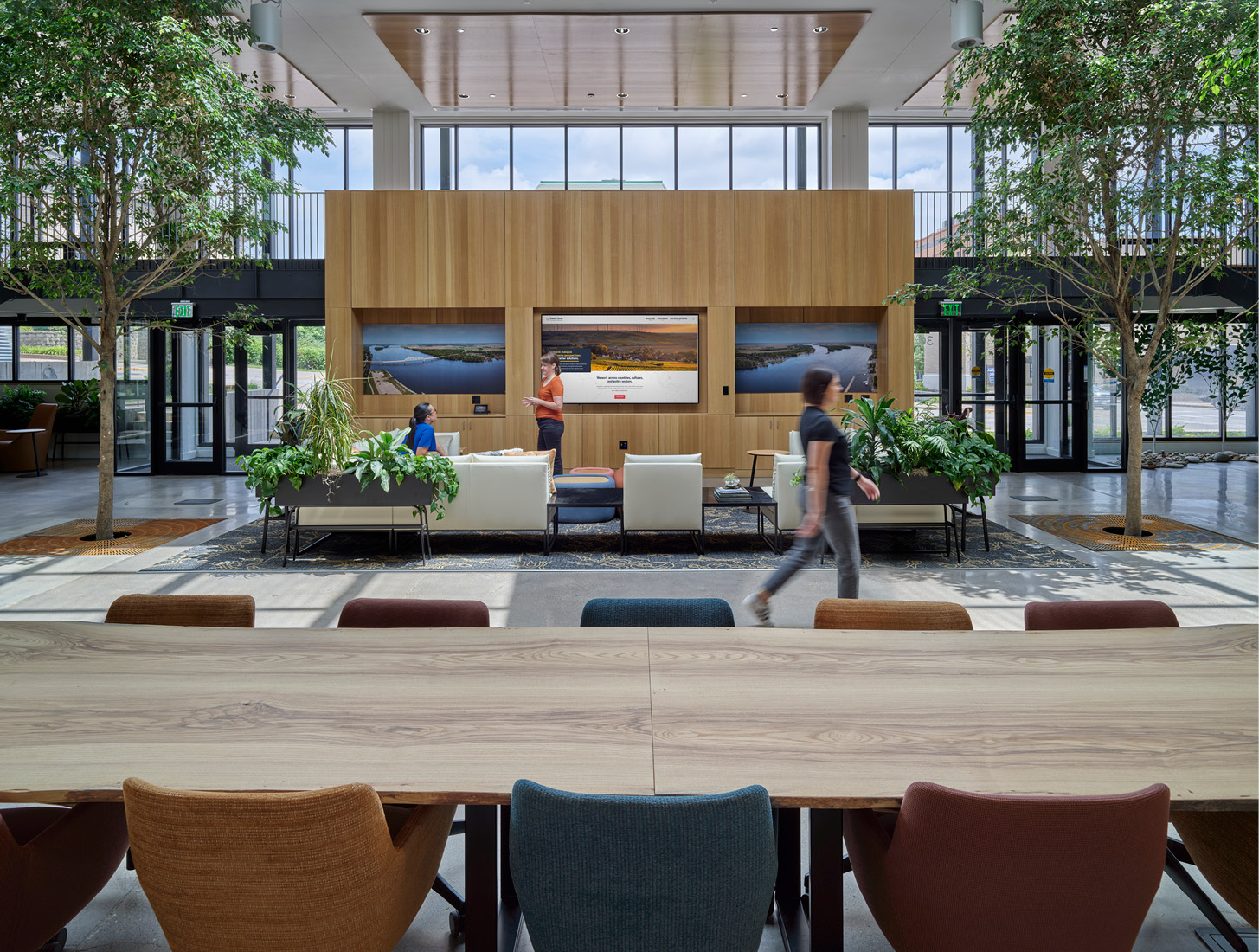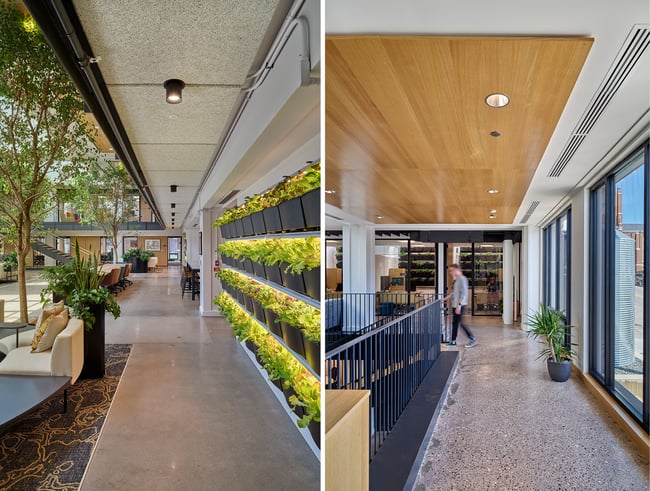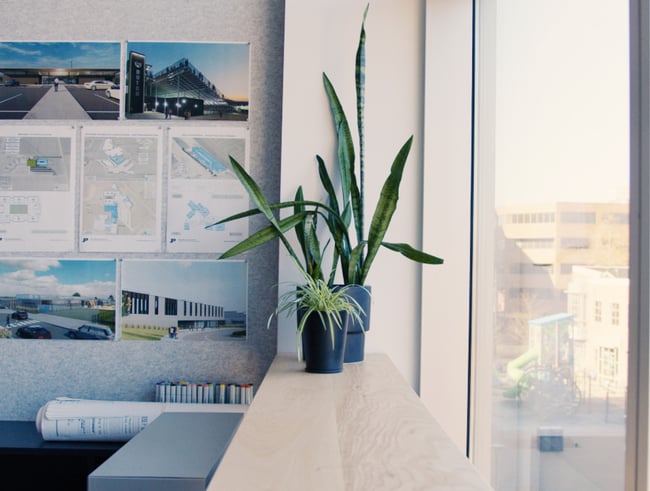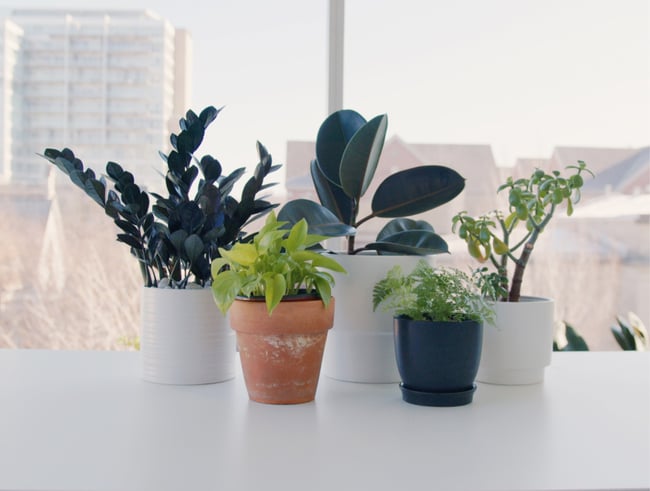Tips for Incorporating Plants into the Workplace

Everyone has an innate desire to be in and around nature—a concept known as biophilia. Unfortunately, the workspaces where we spend most of our time are often stripped of life.
One simple, budget-friendly way to connect occupants with nature is to introduce plants into the office. Anyone who has visited Neumann Monson’s Iowa City studio has witnessed our obsession with plants. When renovating, we made biophilia central to the design and worked to find cost-effective ways to incorporate greenery.
Drawing from our experience, this article will discuss the benefits of incorporating plants into the workplace and some budget-friendly tips.
Benefits of Plants in the Workplace
Incorporating plants into the workplace offers many benefits. First, greenery is a central component of biophilia.
Translating to “love of life” in Greek, biophilia refers to everyone’s desire to connect with nature. It explains why people of all backgrounds and cultures feel rejuvenated after spending time outdoors.
Biophilic design seeks to cultivate our relationship with nature within the built environment and improve occupants’ mental health. Strategies like increasing daylighting and incorporating natural features are known to improve productivity and cognitive function in office settings. Although biophilic design can take many forms, plants are a great starting point.
Plants can also improve physical health. Some varieties, like spider plants and ferns, are known to purify the air and reduce airborne contaminants, protecting occupants within enclosed spaces. Older buildings with outdated ventilation systems can benefit from increasing greenery.
On an aesthetic level, plants add color and texture to your workspace. A mixture of varieties—from grasses to succulents—can add visual interest and make your office more inviting. Depending on the variety, plants can also introduce pleasant aromas into your workspace.
Ultimately, a little greenery goes a long way in keeping your employees engaged and healthy, making your office a more attractive place to work.
4 Tips for Incorporating Plants into the Workspace
1. Consider Your Budget and Maintenance
While plants can be low-cost, pricing depends on your goals. Green walls and indoor trees are at the pricier end of the spectrum, often requiring irrigation systems.
A more budget-friendly option is simply potting plants and placing them throughout the office, the approach we took with our Iowa City studio. This approach is more flexible, allowing you to move plants as your space evolves.

While live walls may require irrigation, potted plants are a more flexible option.
Along with your budget, consider how you will care for the plants. We recommend assigning someone (preferably a volunteer with a green thumb) who is responsible for watering and maintenance.
2. Start with Beginner Plants
Plants can be intimidating, and not every workplace has the optimal lighting conditions for keeping them alive. Thankfully, there are many low-maintenance varieties suitable for office settings.
Philodendrons, pathos, and spider plants can withstand many light conditions and require little maintenance outside occasional watering. Snake plants also do well in low-light conditions, making them ideal for offices with deep floor plates and lower natural light levels.

A snake plant and spider plant.
Other plants we recommend include:
- Jade plants
- Zanzibar Gems (ZZ plants)
- Ficus (Rubber) plants
- Ponytail palms
- Ferns
Once you feel comfortable caring for these low-maintenance plants, you can start experimenting with other varieties. A flowering plant like an orchid can be a great way to add color to your workplace.

A ZZ plant, philodendron, rubber plant, fern, and jade plant.
These plants, however, require bright, indirect light and have special requirements when it comes to watering. Starting simple will help build your confidence before moving on to more tricky varieties.
3. Host a Propagating Party
Introducing plants into your workplace doesn’t have to break the bank. When renovating our Iowa City studio, we didn’t budget for plants. Instead, we hosted an afternoon happy hour where everyone propagated plants from their homes.
As the studio underwent its renovation, people cared for the propagated plantings at home, and by the time we moved into our new studio, we had an abundance of greenery ready to re-pot. The event was a great culture-building activity that helped cultivate an interest in biophilia.
When planning the party, we chose plants that were easy to propagate, like jades, spider plants, and philodendrons.
Determining how to propagate the plants required some research. While some could be planted directly into soil, others needed to sit in water until roots developed. Some could be propagated through their leaves, and others required stems.
Be sure to research your plants and the best techniques for propagating before hosting your party.
4. Coordinate Planters
Lastly, we recommend matching or coordinating planters throughout your workplace. Sticking to a consistent color scheme or material can create a more cohesive look.
Planters don’t need to be expensive. When renovating our Iowa City studio, we had various planters of different colors and materials—some plastic, some ceramic, and some terracotta. While some planters came from our previous studio, others came from thrift stores.
To create a consistent look, we painted some planters with black chalk paint and ended up with a mix of white, black, and terracotta pots. We recommend sticking with a few colors if you have several materials. Similarly, choose a consistent material if you choose to play with color.
Discover the Benefits of Biophilic Design
Workplaces should feel productive, inviting, and invigorating. Incorporating plants is a step in the right direction, adding life to your space and connecting to occupants’ desire to be around nature.
Incorporating plants doesn’t need to be expensive. Host a propagating party, thrift some planters, and slowly introduce life into your workplace.
Environmental features like plants are only one aspect of biophilic design. It’s also important to introduce light, incorporate natural materials, and cultivate a sense of place.
In our experience, biophilic design principles offer a great starting point for vetting design decisions and setting project goals. Learn more by reading about the six principles of biophilic design and how to incorporate them into your project.